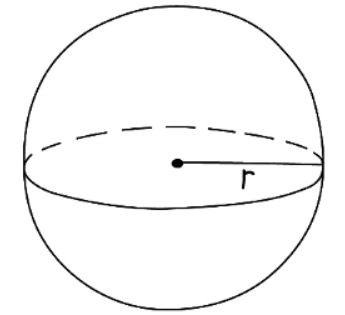Class 10 Exam > Class 10 Notes > Mathematics for GCSE/IGCSE > Surface Area
Surface Area | Mathematics for GCSE/IGCSE - Class 10 PDF Download
What is surface area?
- A face is a flat or curved surface that forms part of a three-dimensional shape.
- The surface area of a three-dimensional shape is the total of the areas of all its faces.
- Observe how we extend a two-dimensional concept (area) into three dimensions in this context.
How do I find the surface area of cuboids, pyramids, and prisms?
- In cuboids, polygonal-based pyramids, and polygonal-based prisms (i.e., pyramids and prisms with straight-sided bases), all faces are flat.
- To find the surface area, simply sum the areas of these flat faces.
- Drawing a 2D net of the 3D shape can be very useful when calculating surface area.
- Example:
- The base of a square-based pyramid has sides measuring 15 cm.
- The triangular faces are identical isosceles triangles, each with a height of 23 cm from the base to the top of the pyramid.
- Calculate the total surface area of the pyramid.
- Draw a net for the shape.
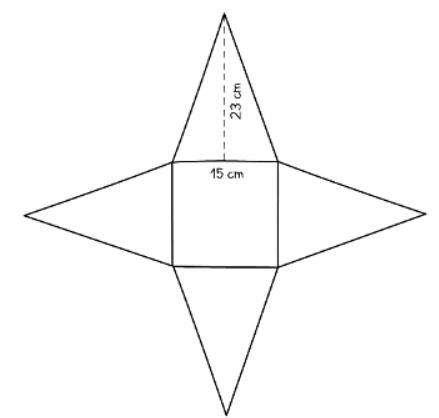
- Area of square base =152 = 225 cm2
- Area of one triangular face = ½ base × height = ½ × 15 × 23 =172.5 cm2
- Total surface area =225 + 4 × 172.5 = 915 cm2
How to find the surface area of cylinders, cones, and spheres?
- All three shapes - cylinders, cones, and spheres - have curved faces, requiring careful consideration when calculating their surface areas.
1. The net of a cylinder consists of two circles and a rectangle
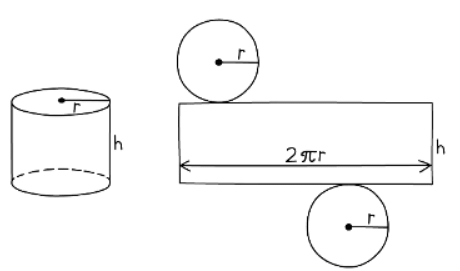
- The curved surface area of a cylinder is bold 2 πrh
- The total surface area of a cylinder with base radius r and height h is therefore given by: Total surface area of a cylinder = 2 πr2 + 2 πrh
2. The net of a cone consists of the circular base along with the curved surface area
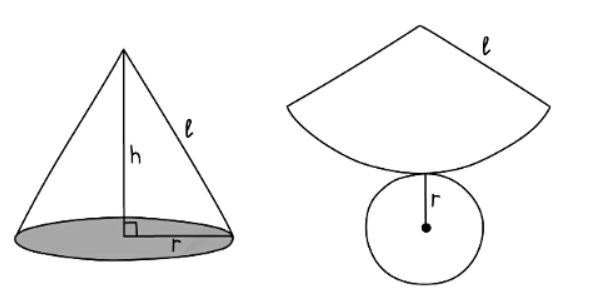
- The slant height in a cone diagram is the oblique height, whereas h represents the vertical height of the cone.
- To calculate the surface area of a cone with base radius r and slant height l, utilize the following formulas:
- Curved surface area of a cone = πrl
- Total surface area of a cone = πr2 + πrl
3. To find the surface area of a sphere with radius r, use the formula
- Surface area of a sphere = 4πr2
- Be careful when calculating the surface area of a hemisphere:
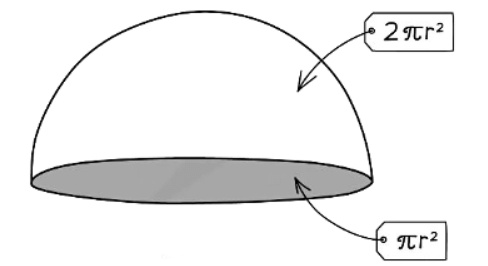
- When computing the surface area of a hemisphere, account for the curved part (half of a sphere) and the flat circular face. The total surface area is 3πr2.
The document Surface Area | Mathematics for GCSE/IGCSE - Class 10 is a part of the Class 10 Course Mathematics for GCSE/IGCSE.
All you need of Class 10 at this link: Class 10
|
38 videos|395 docs|19 tests
|
FAQs on Surface Area - Mathematics for GCSE/IGCSE - Class 10
| 1. What is the formula for calculating the surface area of a cuboid? |  |
Ans. The formula for the surface area of a cuboid is 2lw + 2lh + 2wh, where l, w, and h are the length, width, and height of the cuboid, respectively.
| 2. How do you find the surface area of a pyramid? |  |
Ans. To find the surface area of a pyramid, you can use the formula A = 0.5 × perimeter of base × slant height + base area, where the base area can be calculated separately depending on the shape of the base.
| 3. What is the surface area of a prism and how is it calculated? |  |
Ans. The surface area of a prism is the sum of the areas of all its faces. It can be calculated by finding the area of each face and then adding them together.
| 4. Are there any shortcuts or tricks to calculating surface area quickly? |  |
Ans. One shortcut for calculating the surface area of a cuboid is to add the areas of the faces in pairs (l x w, l x h, w x h) and then double the result. This can help simplify the calculation process.
| 5. How can I use the surface area formulas in real-life scenarios? |  |
Ans. Understanding surface area formulas can be useful in various real-life situations, such as calculating the amount of paint needed to cover a surface, determining the material needed to construct a packaging box, or estimating the cost of materials for a construction project.
Related Searches

